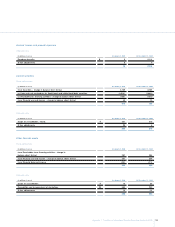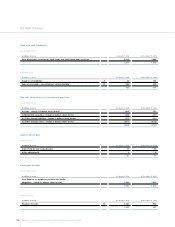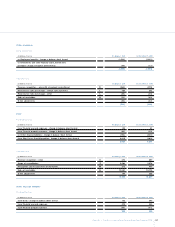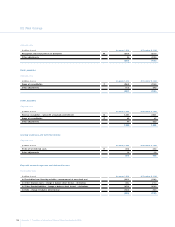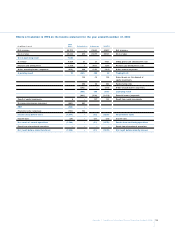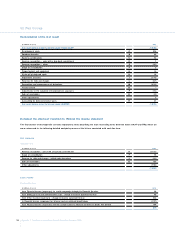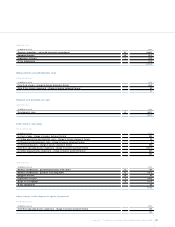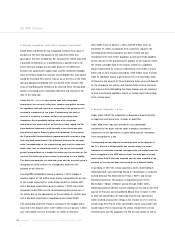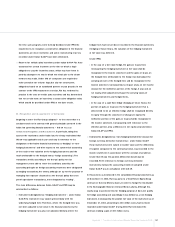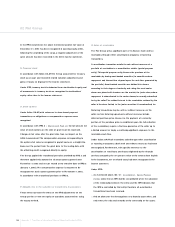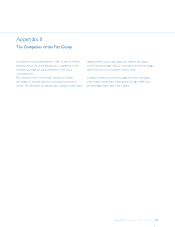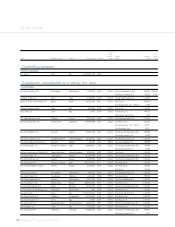Chrysler 2005 Annual Report Download - page 164
Download and view the complete annual report
Please find page 164 of the 2005 Chrysler annual report below. You can navigate through the pages in the report by either clicking on the pages listed below, or by using the keyword search tool below to find specific information within the annual report.
163
Appendix 1 Transition to International Financial Reporting Standards (IFRS)
Description of main differences between italian GAAP
and IFRS
The following paragraphs provide a description of the main
differences between Italian GAAP and IFRS that have had effects on
Fiat’s consolidated balance sheet and income statement.Amounts are
shown pre-tax and the related tax effects are separately summarised
in the item R.Accounting for deferred income taxes.
A. Development costs
Under Italian GAAP applied research and development costs may
alternatively be capitalised or charged to operations when incurred.
Fiat Group has mainly expensed R&D costs when incurred. IAS 38 –
Intangible Assets requires that research costs be expensed, whereas
development costs that meet the criteria for capitalisation must be
capitalised and then amortised from the start of production over the
economic life of the related products.
Under IFRS, the Group has capitalised development costs in the Fiat
Auto, Ferrari-Maserati,Agricultural and Construction Equipment,
Commercial Vehicle and Components Sectors, using the retrospective
approach in compliance with IFRS 1.
The positive impact of 1,876 million euros on the opening IFRS
stockholders’ equity at January 1, 2004, corresponds to the cumulative
amount of qualifying development expenditures incurred in prior years
by the Group, net of accumulated amortisation. Consistently, intangible
assets show an increase of 2,090 million euros and of 2,499 million
euros at January 1, 2004 and at December 31, 2004, respectively.
The 2004 net result was positively impacted by 436 million euros in the
year, reflecting the combined effect of the capitalisation of development
costs incurred in the period that had been expensed under Italian
GAAP, and the amortisation of the amount that had been capitalised in
the opening IFRS balance sheet at January 1, 2004.This positive impact
has been accounted for in Research and development costs.
In accordance with IAS 36 – Impairment of Assets, development costs
capitalized as intangible assets shall be tested for impairment and an
impairment loss shall be recognised if the recoverable amount of an
asset is less than its carrying amount, as further described in the
paragraph I. Impairment of assets.
B. Employee benefits
The Group sponsors funded and unfunded defined benefit pension
plans, as well as other long term benefits to employees.
Under Italian GAAP, these benefits, with the exception of the
Reserve for Employee Severance Indemnities (“TFR”) that is
accounted for in compliance with a specific Italian law, are mainly
recorded in accordance with IAS 19 – Employee Benefits, applying
the corridor approach, which consists of amortising over the
remaining service lives of active employees only the portion of net
cumulative actuarial gains and losses that exceeds the greater of
10% of either the defined benefit obligation or the fair value of
the plan assets, while the portion included in the 10% remains
unrecognised.
W ith the adoption of IFRS,TFR is considered a defined benefit
obligation to be accounted for in accordance with IAS 19 and
consequently has been recalculated applying the Projected Unit
Credit Method.
Furthermore, as mentioned in the paragraph “O ptional
exemptions”, the Group elected to recognise all cumulative
actuarial gains and losses that existed at January 1, 2004, with a
negative impact on opening stockholders’ equity at that date of
1,247 million euros.
Consequently pension and other post-employment benefit costs
recorded in the 2004 IFRS income statement do not include any
amortisation of unrecognised actuarial gains and losses deferred in
previous years in the IFRS financial statements under the corridor
approach, and recognised in the 2004 income statement under Italian
GAAP, resulting in a benefit of 94 million euros.
The Group has elected to use the corridor approach for actuarial
gains and losses arising after January 1, 2004.
Furthermore, the Group elected to state the expense related to the
reversal of discounting on defined benefit plans without plan assets
separately as Financial expenses, with a corresponding increase in
Financial expenses of 127 million euros in 2004.
C. Business combinations
As mentioned above, the Group elected not to apply IFRS 3 -
Business Combinations retrospectively to business combinations that
occurred before the date of transition to IFRS.
As prescribed in IFRS 3, starting from January 1, 2004, the IFRS
income statement no longer includes goodwill amortization charges,
resulting in a positive impact on O ther operating income and
expense of 162 million euros in 2004.




